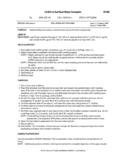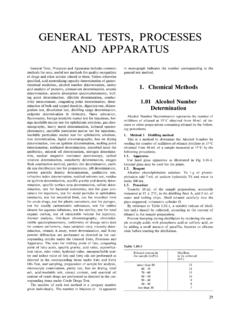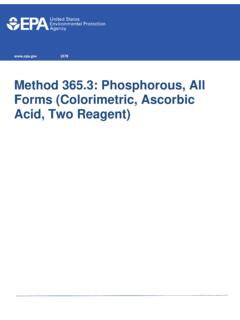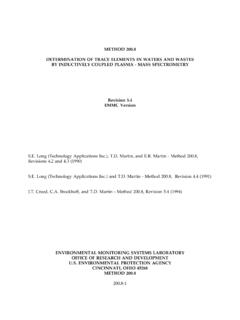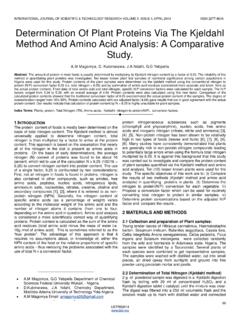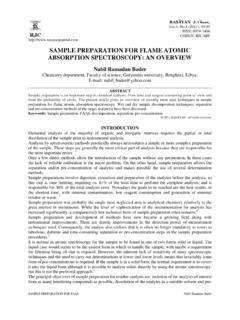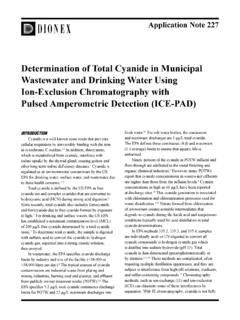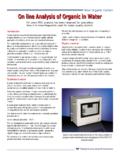Transcription of ELEMENTS by ICP 7303 (Hot Block/HCl/HNO3 …
1 NIOSH Manual of Analytical methods (NMAM), Fourth EditionELEMENTS by ICP7303(Hot Block/HCl/HNO3 digestion )MW: Table 1 CAS: Table 2 RTECS: Table 2 METHOD: 7303, Issue 1 EVALUATION: PARTIALI ssue 1: 15 March 2003 OSHA: Table 2 NIOSH: Table 2 ACGIH: Table 2 PROPERTIES: Table 1 ELEMENTS :aluminumcadmiumindiumnickelstro ntiumzincantimony*calciumironpalladiumte lluriumarsenicchromiumlead*phosphorustha lliumbariumcobaltmagnesiumplatinumtin*be rylliumcoppermanganesepotassiumtitaniumb ismuth*galliummolybdenumseleniumvanadium borongoldneodymiumsodiumyttrium* With certain restrictions (see Table 3)SAMPLINGMEASUREMENTSAMPLER:FILTER( :m, cellulose ester membrane)FLOW RATE:1 to 4 L/minVOL-MIN:Table 1 -MAX:Table 1 SHIPMENT:RoutineSAMPLESTABILITY:StableBL ANKS:2 to 10 field blanks per setTECHNIQUE:INDUCTIVELY COUPLED ARGONPLASMA, ATOMIC EMISSIONSPECTROSCOPYANALYTE:See element list aboveREAGENTS:Conc.
2 HCl, mL; and conc. HNO3, mLFINALSOLUTION:5% HCl and 5% HNO3, 25 mLWAVELENGTH:Element and instrument specificBACKGROUNDCORRECTION:Spectral wavelength shiftCALIBRATION: ELEMENTS in 5% HCl, 5% HNO3 RANGE:LOQ to 50,000 :g/sample [1]ESTIMATED LOD:Varies with element; Table 1 PRECISION ( ):Not evaluatedACCURACYRANGE STUDIED:5,000 to 50,000 :g/sample BIAS:Not determinedOVERALL PRECISION:Not determinedACCURACY:Not determinedAPPLICABILITY: The working range of this method is up to 100 mg/m3 for each element in a 500-L sample (the minimumrange depends on the LOD for each sample; see Table 1). The analysis is not compound specific. Certain elementalcompounds are known to be acceptable or unacceptable by this method (see Table 3). For unverified compounds, a test runshould be conducted using a known amount of the compound in question to determine : Interferences are spectral in nature and are accounted for by choosing appropriate wavelengths, applyinginterelement correction factors, and background methods : Alternative, more sensitive methods exist for some ELEMENTS by graphite furnace atomic absorptionspectroscopy.
3 This method is similar to NIOSH Method 7301, differing only in the use of the hot block for digestion of by ICP (Hot Block/HCl/HNO3 Ashing): METHOD 7303, Issue 1, dated 15 March 2003 - Page 2 of 6 NIOSH Manual of Analytical methods (NMAM), Fourth EditionREAGENTS: acid,* conc., ultra pure. acid,* conc., ultra pure. stock solutions, 50-1000 : available single elementsolutions or multielement solutions preparedas instructed by the instrument manufacturer. , prepurified. , deionized, Type II water. solution: 5% HCl : 5% HNO3. Toabout 600 mL of deionized water in a 1-Lvolumetric flask, slowly add 50 mL conc. HCland 50 mL conc. HNO3. Dilute to the markwith deionized water.*See SPECIAL PRECAUTIONSEQUIPMENT: : cellulose ester membrane filter, :m pore size, 37-mm diameter; in cassettefilter sampling pump, 1 to 4 L/min, withflexible connecting coupled argon plasma-atomicemission spectrometer, equipped as specifiedby the manufacturer for analysis of elementsof block apparatus at 95 vessels and caps, , electronic and , two-stage, for PRECAUTIONS: Concentrated acids are powerful oxidizers, toxic, and corrosive liquids.
4 Wear protective clothing and work in a fume : each personal sampling pump with a representative sampler in line. at an accurately known flow rate between 1 and 4 L/min for a total sample size of 200 to 2000 Lfor TWA measurements. Do not exceed a filter loading of approximately 2 mg total PREPARATION: the cassette filter holder and with forceps remove the sample filter. Fold the filter into quarterstaking care not to lose any sample, and transfer to a clean, 50-mL hot block digestion tube. mL HCl. Cover with a plastic watchglass. Place in the hot block and heat at an internaltemperature of 95 /C for 15 :The internal temperature may vary from the digital readout. Calibrate the hot block prior todigestion. the sample from the hot block and cool for 5 minutes. Remove watchglass and add mLHNO3.
5 Replace watchglass and return to hot block at 95 /C for 15 minutes. the sample from the hot block and cool for at least 5 minutes. Rinse watchglass into the samplecontainer and discard watchglass. to 25-mL final volume with distilled, deionized Type II AND QUALITY CONTROL: the spectrometer according to the manufacturer's recommendations. Use standards consistingof the same 5% HCl : 5% HNO3 matrix as the samples. a standard every 10 a media blank every 20 samples, and a reagent blank every 10 a set of two laboratory control samples every 40 samples of a given matrix for a given recoveries with at least two spiked media blanks per ten :In the determination of lead, there may be a measurement interference (for example, sampleswith high aluminum levels). More recent instruments have a correction for this.
6 ELEMENTS by ICP (Hot Block/HCl/HNO3 Ashing): METHOD 7303, Issue 1, dated 15 March 2003 - Page 3 of 6 NIOSH Manual of Analytical methods (NMAM), Fourth spectrometer to conditions specified by standards, samples and quality control :If the elemental value for a sample is above the linear range of the element(s) in question, dilutethe sample solution with 5% HCl : 5% HNO3 diluting solution, reanalyze and apply the appropriatedilution factor in the the solution concentrations for the sample, Cs (:g/mL), and the average media blank, Cb (:g/mL),from the the solution volumes of sample, Vs (mL), and media blank, Vb (mL), calculate the concentration,C (mg/m3), of each element in the air volume sampled, V (L):NOTE: :g/L / mg/m3 EVALUATION OF METHOD:The method was evaluated for all ELEMENTS and compounds listed in Table 1 and Table 2 between 1999 and2001 using known amounts of bulk material [4].
7 Evaluation is ongoing for additional ELEMENTS andcompounds. The limits of detection and quantitation were also determined for each element. Two ICPinstruments were used in the evaluation, a Thermal Jarrell Ash Model 61E [5] and a TJA IRIS [6], operatedaccording to the manufacturer's instructions. REFERENCES:[1]WOHL [2001]. Metals validation using hot block digestion , Unpublished data. Wisconsin OccupationalHealth Laboratory, Madison, WI.[2]NIOSH [1994]. Method 7300: ELEMENTS by ICP, NIOSH Manual of Analytical methods , Fourth Edition,Issue 2, Aug. 15, 1994.[3]WOHL [2001]. Metals Manual 2001, WOHL Internal Document, Updated Apr. 1, 2001. WisconsinOccupational Health Laboratory, Madison, WI.[4]WOHL [2001]. WOHL General Operations Procedures Manual, WOHL Internal Document, Updated2001.
8 Wisconsin Occupational Health Laboratory, Madison, WI.[5]Thermal Jarrell Ash [1991]. ICAP 61E Plasma Spectrometer Operator's Manual, Thermal Jarrell AshCorp., Part No. 128832-01, Feb., 1991.[6]Thermal Jarrell Ash [1997]. IRIS Plasma Spectrometer User's Guide, Thermal Jarrell Ash Corp., Part , Feb. 4, WRITTEN BY: Jason Loughrin, Lyle Reichmann, Doug Smieja, Shakker Amer, Curtis Hedman Wisconsin Occupational Health Laboratory (WOHL). ELEMENTS by ICP (Hot Block/HCl/HNO3 Ashing): METHOD 7303, Issue 1, dated 15 March 2003 - Page 4 of 6 NIOSH Manual of Analytical methods (NMAM), Fourth EditionTABLE 1: ANALYTE INFORMATION FOR VALID ELEMENTS AND COMPOUNDSA nalytePropertiesMW MP ( C)LOD(:g/mL)LOQ(:g/mL)EstimatedLOQ(:g/sa mple)*Minimum** air vol. (L)Maximum**air vol. (L)Al 210,000As 85,000, 13,300B 13, 1100,000Be 3525,000, 110,000Ca 210,000 CaO 310, 3500,000Co 3500,000Cr 8500,000Cu 15500,000Fe 15,000Fe2O3(as Fe)
9 15,000Ga 13, 15500,000Mg 110,000 MgO 533,000Mn ,000Mo ,000Nd ,300Ni 150,000P 25 250500, 35100, , 20025,000, 3100,000Se 8250, 125,000Sr 300100,000, 125500,000Ti , 35500,000V ,000Y ,000Zn ,000 ZnO ,000*Value based on a 25-mL sample volume.**The minimum sampling volume needed to obtain the OSHA PEL at the LOQ for the element/compoundat a sample digestion volume of 25 mL.**The maximum sampling volume for a given sample, calculated by taking 50,000 :g as the limit for theelement/compound per :The LOD and LOQ values are dependent on the particular analytical instrument used.
10 Also,LOD and LOQ values may vary for a particular element due to certain by ICP (Hot Block/HCl/HNO3 Ashing): METHOD 7303, Issue 1, dated 15 March 2003 - Page 5 of 6 NIOSH Manual of Analytical methods (NMAM), Fourth EditionTABLE 2. EXPOSURE LIMITS, CAS #, RTECSE lement(Symbol)CAS #RTECS Exposure Limits, mg/m3 (Ca = carcinogen) OSHA NIOSH ACGIHS ilver (Ag) (dust, fume, metal) (metal, soluble) (metal) (soluble)Aluminum (Al)7429-90-5BD033000015 (total dust) 5 (respirable)10 (total dust)5 (respirable fume)2 (salts, alkyls)10 (dust)5 (powders, fume)2 (salts, alkyls)Arsenic (As)7440-38-2CG0525000variesC , , CaBarium (Ba) (Be) , C , , CaCalcium (Ca)7440-70-2--variesvariesvariesCadmium (Cd) feasible, (total), (respir.), CaCobalt (Co) (dust, fume) (dust, fume)Chromium (Cr) (Cu)7440-50-8GL53250001 (dust, mists) (fume)1 (dust) (fume)1 (dust, mists) (fume)Iron (Fe)7439-89-6NO456550010 (dust, fume)5 (dust, fume)5 (fume)Potassium (K)7440-09-7TS6460000------Lanthanum7439 -91-0-- --Lithium (Li)7439-93-2--------Magnesium (Mg)7439-95-4OM210000015 (dust) as oxide5 (respirable)10 (fume) as oxide10 (fume) as oxideManganese (Mn)7439-96-5OO9275000C 51; STEL 35 (dust)1.










